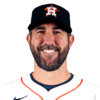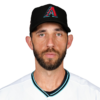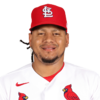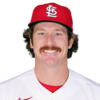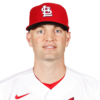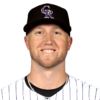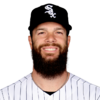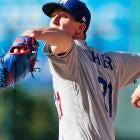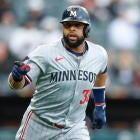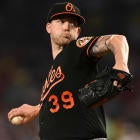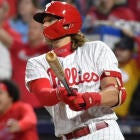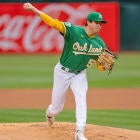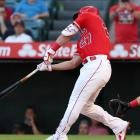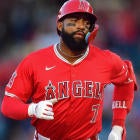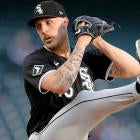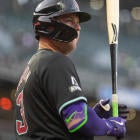Going 20 deep certainly won't cut it. Neither will 30 deep, like in the outfield. Even 40 deep just barely scratches the surface of what starting pitcher has to offer.
And yet you get a pretty good sense of the distribution of talent even with this abbreviated look.
There are more gradients here than at the start of 2018, when the position was divided into those who might make a difference and those who probably wouldn't. Now, there's the old-guard aces at the top, followed by the newcomers and those who fell off a little in 2018. Then come the pitchers who flashed ace potential, particularly down the stretch, and those who clearly weren't themselves in 2018 but have earned the benefit of the doubt. By the end of the top 40, the upside doesn't really compare, and not too long after that is when our expectations become fairly interchangeable.
Grabbing two of the top 17 would probably be a priority for me, as well as a third in the 18-30 range.
Max Scherzer will turn 35 next year but shows no signs of slowing down, not only putting together six straight seasons with at least 200 innings and 240 strikeouts but also setting a career high in K/9 for a third straight year. That rare combination of dominance and durability makes him the surest thing among starting pitchers.
Chris Sale is nearly as dominant as Scherzer, and also has a lengthy track record, but his recent shoulder issues put him a step behind in terms of durability. Don't be surprised if he joins Scherzer in the first round, though.
Arguably the best pitcher of 2018, Jacob deGrom is nonetheless a newcomer to the Scherzer-Sale class of pitchers, though he had been a highly regarded Fantasy asset since breaking into the big leagues in 2014. His 1.99 FIP would suggest that what he accomplished this year wasn't as fluky as it might appear.
Corey Kluber kept himself in the Cy Young mix for the fourth time in four years, but he wasn't as dominant as during his winning 2017 season, taking a step back in terms of strikeout rate and swinging-strike rate. Neither dropped into an unfamiliar range for him, though, and there just aren't many pitchers you can bank on for 200 innings year after year.
Justin Verlander will be 36 on opening day next year, which is reason enough to bump him down a peg, but he's still cranking it up to 99 mph and seems to have found another gear with the data-mining Astros, setting career highs in several categories this year. And that's saying something for a pitcher who once won a league MVP.
The best of his generation no longer deserves the benefit of the doubt health-wise, not after spending time on the DL for the fourth time in five years. Clayton Kershaw is the first in these rankings for whom 200 innings can't be the expectation, and even worse, his stuff appears to be on the decline. The end numbers were still ace-like, but the concerns are mounting.
The Rays handled Blake Snell with kid gloves after his midseason DL stint for a shoulder issue, but he was straight fire to close out the season, demonstrating for the first time the unhittable quality that defined his minor-league career. The walks are a little concerning, as is the Rays' chaotic handling of pitchers, but Snell has the look of another Chris Sale.
Aaron Nola certainly moved himself into the elite tier with a performance that might have captured the Cy Young award in most seasons, but there are some potential pitfalls — namely, a too-low-to-believe BABIP and home-run rate, and a slightly underwhelming K/9 for a pitcher of this stature. They're minor gripes, but reasons to suspect he'll be a little worse in 2019.
A broken leg interrupted what was shaping up to be a Cy Young season for Trevor Bauer, who doubled down on his lessons learned during a transformative 2017 by emphasizing his breaking balls more than ever. He may have benefited from some home run luck, but his AL-leading 2.44 FIP gives him some wiggle room there.
Clearly, the Astros performed some of their data-mining magic on Gerrit Cole, who led all the majors in K/9 after failing to live up to his ace potential in Pittsburgh. But there was what he did during the first two months and what he did over the final four, struggling to throw even six innings a start down the stretch.
When a pitcher makes a statistical leap, the reason isn't always so easy to pinpoint, but in Patrick Corbin's case, it's pretty simple: He increased his already heavy slider usage, making it essentially his primary pitch, and in doing so led all the majors in swinging-strike rate. He did give up a high rate of hard contact, though, so where he ultimately signs will have some say in his final ranking.
This is a little higher than we're used to seeing Carlos Carrasco, but every year he seems to get a little better. It's unlikely he ever makes a serious play for the Cy Young award, but he's always on the fringes of it. And reliability goes a long way at this position.
This season was a double whammy for Noah Syndergaard, who again couldn't stay healthy for 30 starts and turned in career-worst strikeout and walk rates in the starts he did make. But his swinging-strike rate was pretty normal, as was his velocity, and it's not like he had bad numbers when all was said and done. It's harder to justify the downside when the upside is in question, though.
Luis Severino completely lived up to his breakthrough 2017 for the first three months of 2018, looking like a Cy Young front-runner, and then suddenly become much more hittable over the final three. It wasn't all bad for him down the stretch — his elite velocity and swinging-strike rate remained more or less intact — but his slider wasn't as overpowering as we're used to seeing, which raises concern for what would otherwise be a surefire ace next year.
Zack Greinke has become the ultimate better-safe-than-sorry pick among early-round pitchers, with 2016 (his first season with the Diamondbacks) representing the only real blemish over the last decade. Maybe one of these years, his age will catch up to him, but given his relative soft-tosser status and reliance on command, it's not as big of a concern for him as it is for even Verlander.
James Paxton had his moments this year (most notably a May 8 no-hitter on the heals of a 16-strikeout effort) that validated his standing as a front-line Fantasy pitcher, but he couldn't make it through the season healthy and, despite approaching his 30th birthday, never has. He's like a left-handed Syndergaard, only the risks feel even more established.
Speaking of risks, Stephen Strasburg is yet another ace who can't be trusted to make 30 starts seeing as he hasn't done it in five years. And was he really back to normal in September after a DL stint for a shoulder impingement? The velocity was down a little, but it's too early to sound the alarm, especially given his track record of ace production on a start-by-start basis.
As strange as it sounds given the presence of Clayton Kershaw, Walker Buehler was the Dodgers' best pitcher down the stretch, continually one-upping himself to put to rest any thoughts of an innings limit. The rookie pitched well from the get-go, but once he began emphasizing his breaking balls midseason, he became near unhittable, delivering a 1.55 ERA over his final 12 starts. He made a big leap in innings, though, and will need to make another to hang with the true aces.
As good as Buehler was down the stretch, German Marquez was the big breakout pitcher of the second half, shoring up his mechanics to make his secondary arsenal more effective — and boy was it effective. He still has to overcome the inherent disadvantages of pitching at Coors Field, but while the season-long splits were unfavorable, he dominated everywhere over the final two months, putting together six double digit-strikeout efforts.
Truth is Mike Clevinger probably deserves more credit than this coming off a 200-inning season with more than a strikeout per inning, but when you're the fourth-best pitcher on your team and lack the ceiling of a Stephen Strasburg or James Paxton ... well, somebody has to get bumped. Clevinger has a thin track record and a FIP that suggests he overachieved a little, but he's absolutely somebody to target.
Track record has to count for something, which is why I'm not completely burying Madison Bumgarner even though he hasn't been the same since spraining his shoulder in a dirt bike accident last April. Specifically, his velocity is down and he's allowing much more contact. He still handles an ace workload, which counts for plenty in today's game, but it's a slippery slope given his eroding production.
Carlos Martinez finished the year as the Cardinals closer, not ace, but that's because he kept landing on the DL with lat and oblique injuries and eventually reached a point where he didn't have enough time to rehabilitate as a starter. So he'll enter next year as a relief pitcher-eligible starter, but one with serious durability concerns and what's actually a suspect strikeout-to-walk ratio.
Jack Flaherty was the rookie pitcher who initially looked like he might make the sort of impact Buehler ended up making, piling up swinging strikes from the get-go, but some control issues derailed him in the final month. Still, the soon-to-be 23-year-old made his presence known with a big fastball, two plus breaking balls and the typical oohs and aahs that accompany the next big thing.
Recovering from two disappointing seasons in Boston, including a 2017 that was nearly lost to a concerningly vague elbow issue, David Price got back to being a workhorse this year. The swinging-strike rate doesn't jibe with his K/9, which might hint of a mirage if the same wasn't true during some of his best years with the Rays. He's not a "safe" choice at age 33, but we're beyond safe at this point in the rankings.
The most validating aspect of Mike Foltynewicz's breakthrough 2018 is that he maintained strong numbers into September, but he still didn't showcase a particularly diverse arsenal, still didn't generate a ton of swings and misses and still didn't overcome the control issues that limited him earlier in his career. So what was behind the breakthrough? Seems like more than just a low BABIP given that he had nearly 10 strikeouts per nine innings, but he's still not completely trustworthy.
Like Foltynewicz, Zack Wheeler is known mostly for his big fastball, and like Foltynewicz, it carried him to new heights last season, resulting in an unsustainable but nonetheless impressive 2.06 ERA over his final 15 starts. After an unusually long recovery from Tommy John surgery, it was the sort of performance he needed to get back in Fantasy owners' good graces, but he also ended up throwing about 100 more innings than in the previous three years combined.
Rounding out the slow-developing-prospect portion of the rankings is Jameson Taillon, whose transformation you can trace back to a singular event: He introduced a slider May 27, rounding out his arsenal in a way that inspired him to throw all of his secondary pitches more, and the result was a 2.71 ERA the rest of the way. He doesn't have quite the strikeout potential of Foltynewicz or Wheeler, but he's arguably safer.
A tricky pitcher to rank given that his strengths are a complete departure from today's norm, the fact is that despite a low strikeout rate, Miles Mikolas' 3.28 FIP supports what he did in his first year back from Japan, dominating in the other two areas a pitcher directly controls -- walks and home runs. If he remains an elite control and ground-ball pitcher, he'll be as good next year, but any slippage in either area could hurt.
It was easy to hope for more from Chris Archer, clinging to the idea that he consistently underperformed his FIP when he was striking out 250 batters a year, but it's a tougher sell after a year like 2018. But the skill indicators were close enough to normal — same elite velocity, same elite swinging-strike rate — that there's a good chance he makes it a distant memory, especially now that he's out of the AL East. Conservative ranking here.
Masahiro Tanaka is actually a ground-ball pitcher, but he has proven to be so susceptible to the long ball that this year's 3.75 mark is about the lowest ERA you could reasonable expect from him. He also hasn't been a model of health, only once reaching 180 innings in his five-year career, so by now, I feel confident saying he doesn't have the upside of any of the pitchers ahead of him on this list.
This is the sort of ranking that's so based on a hunch it's liable to rise or fall 10 spots according to the latest offseason report or spring outing. Yu Darvish of course was one of the elites in Fantasy before face-planting in his first two months as a Cub and then having elbow debridement surgery, but he was showing signs of turning things around before the injury. I may be going the overly cautious route here.
Charlie Morton rode the momentum of his 2017 World Series performance into some front-line numbers for the first four months of 2018. But then he changed his approach over the final two months, right around the time he was contending with shoulder discomfort, leaning on his two-seamer for more of a ground-ball approach. It's hard to say, then, what to expect from the would-be 35-year-old next year, but durability seems to be an issue.
Jose Berrios looked like a breakout on the level of Blake Snell and Aaron Nola at the start of 2018, issuing just one walk over his first five starts, consistently pitching seven innings or more and putting together several starts with double-digit strikeouts. But then the command issues that marred the first couple years of his career popped up again midseason and unraveled it all. We got a taste of the upside, though, and it was sweet.
Going out on a limb a little for this one, but after disappointing early, Luis Castillo had an awesome September and actually put together a 2.44 ERA for the entire second half. Between his 99-mph fastball, arguably the best changeup in the game and his ability to throw both for strikes, there's still ace potential here even though his sophomore season didn't go as planned.
If you compare Cole Hamels' numbers with the Cubs to those with the Rangers, and then compare what he did in his home starts with the Rangers to what he did in his road starts ... yeah, it's pretty clear he needed to get out of there. It ended up being a strong bounce-back campaign for a pitcher who looked washed in 2017, reflected most in the strikeout and swinging-strike rates, but clearly where he signs this offseason will impact his 2019 value.
Every couple years or so, J.A. Happ introduces a new trick that forces us to reconsider everything we profess to know about him, and this year, it was his sudden transformation into a bat-misser. He did flash this ability once before — in a partial season with the Pirates in 2015 — and accomplished it the same way both times: emphasizing his fastball more. Here's betting it wasn't all smoke and mirrors.
It's not as aggressive a ranking as I'd like to have for Ross Stripling, who put together what would be the third-best strikeout-to-walk ratio among qualifying starting pitchers (behind Justin Verlander and Corey Kluber) if he hadn't missed most of the second half with toe and back issues. There was talk of moving him to the bullpen before then, and with Julio Urias expected back, it remains a possibility.
Kyle Freeland has two major knocks against him: a pitch-to-contact approach in an era that rarely allows one and, of course, Coors Field. Either on its own would normally prohibit this sort of ranking, so you'd think the two together would be a non-starter. But the expected correction never came in 2018, to the point of making him a fringe Cy Young candidate with a top-five bWAR. You're right not to trust him, but you can pass him over for only so long.
Though overtaken by Mikolas as Fantasy's preferred ground-ball pitcher, Dallas Keuchel was still the best in the majors in that particular measurement, even if he wasn't quite the outlier he normally is. He stayed healthy for the first time since his Cy Young 2015 season, but his breaking ball wasn't as sharp, removing an element of deception and making him more pitch-to-contact than he already is. I'll take a better-safe-than-sorry approach, especially given his injury history.
Rick Porcello has a reputation as more of a pitch-to-contact guy, much like Freeland and Keuchel, but he was actually right at a strikeout per inning this year. A second-half skid wherein he seemed to lose confidence in his two-seamer interrupted what was a bounce-back season as a top-of-the-rotation arm, but he's such an efficient pitcher that he should be in a position to win plenty of games again for the high-scoring Red Sox.














